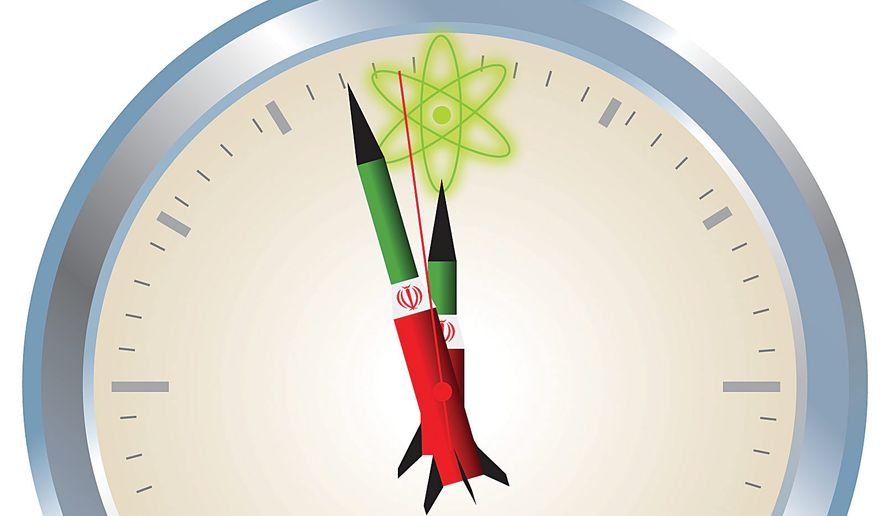OPINION:
It has been known in the nuclear arms community for the last six years that the Iranians had secured enough enriched U-235 for the creation of a first-generation implosion bomb. Further to this point, the construction of an actual bomb small enough to be dropped from a transport plane, or carried by a fishing trawler or small freighter, has been judged to be available since 2010.
Using International Atomic Energy Agency (IAEA) reports, the Wisconsin Project on Nuclear Arms Control tracked the availability of Iran having nearly 8,000 kilograms of weapons-grade uranium through February 2015. This figure points to the ability to create seven original implosion-type bombs if the enrichment was brought to 90 percent. The usual time element for such enrichment is calculated at three to 12 months. There is no reason to believe this minimal time element has not been accomplished.
This information is not hard to obtain, so what is the real mission that Secretary of State John Kerry is so steadfastly pursuing and to which President Obama is so committed as a March 31 deadline for an agreement looms? It’s been obvious for some time that the Iranians have invested billions in cash and materiel in building a string of heavily protected nuclear development facilities. It is accepted internationally that these variously clandestine installations are, among other tasks, capable of enriching U-235 to weapons-grade and marrying the detonation mechanism appropriately reduced in size with an intercontinental missile capability. Tehran has already announced it has succeeded in creating such intercontinental missile hardware, as indeed so have their grateful friends, the oil-needy North Koreans.
U.S. government nuclear strategists have long agreed that Iran’s use of nuclear material to fuel its powerful electricity producing power plant at Bushehr has in no way hindered the accumulation of uranium hexafluoride (UF6) enriched to 3.5 percent U-235. Adding to this information is the last IAEA report that at just the Natanz fuel enrichment plant, 9,000 first-generation IR-1 centrifuges were “being fed with UF6.” Theoretical estimates have been made that this means only 1.7 months would be necessary “to produce enough enriched uranium for one bomb,” Valerie Lincy and Gary Milhollin of the Wisconsin Project on Nuclear Arms Control wrote on Feb. 24 in “Iran’s Nuclear Timetable.”
Apparently, the White House is willing to overlook these obvious and publicly available facts in order to arrive at some form of entente with the leadership in Tehran. The Persian proclivity for calculated prevarication has been well reviewed previously in discussion of the Shia concept of “taqiyah,” defined as “dissembling for the protection and extension of the faith.”
Somehow Mr. Obama and his national security team have lost sight of the basic elements of intelligence analysis in order to seek a treaty with a country under radical Islamic clerical control. For an American administration to say that it seeks a broad-ranging accord that “will prevent Iran from obtaining a nuclear weapon” borders on the absurd. The rest of the world knows well the substantial extent to which Tehran already has gone in order to acquire that capability. The question, therefore, arises: What exactly is the Obama White House’s aim?
It appears that Mr. Obama believes allowing Iran surreptitiously to arm itself with basic nuclear weapons actually insures it will not use them. It is an interesting theory that hearkens back to the logic personified by Prime Minister Neville Chamberlain in 1938 to justify the Munich agreement with Adolf Hitler that the British prime minister heralded as bringing “peace in our time” while stripping Sudetenland from Czechoslovakia.
Just as Chamberlain’s belief in granting aggressive opponents what they wish in order to avoid physical conflict, Washington in recent years has pretended that economic sanctions were an adequate device to force the Iranians to halt nuclear weapon development. This futile policy was carried out while ignoring the nuclear ambition that Tehran has espoused going all the way back to Shah Reza Pahlavi. The Saudi and other Gulf intelligence services have tracked and reported on the many foreign technical advisers — Russian, North Korean, South Asian and Latin American — who have become rich in their roles of advice and assistance in Persian nuclear weapon development. The most successful of these “contractors” was Dr. A.Q. Khan, the nuclear scientist hero of Pakistan who admitted assisting North Korea and Iran in their scientific and technical nuclear development.
It is in this arcane environment that the Obama government has chosen to create a broad-ranging dialogue with the clerical leadership of Iran over the latter’s ventures into nuclear armament. Does Mr. Obama actually think that Iran will cease its ambition to dominate the Middle East? Is he unaware that the key to such domination is a military prowess capable of threatening its neighbors and the region at large? The answer is to be left to future historians. At this stage, however, the potential is deadly, and the next American chief executive will have to deal with it — if he or she can.
• George H. Wittman was the founding chairman of the National Institute for Public Policy. He is a member of the Committee on the Present Danger.




Please read our comment policy before commenting.